2019 MERCEDES-BENZ CLA parking brake
[x] Cancel search: parking brakePage 152 of 330
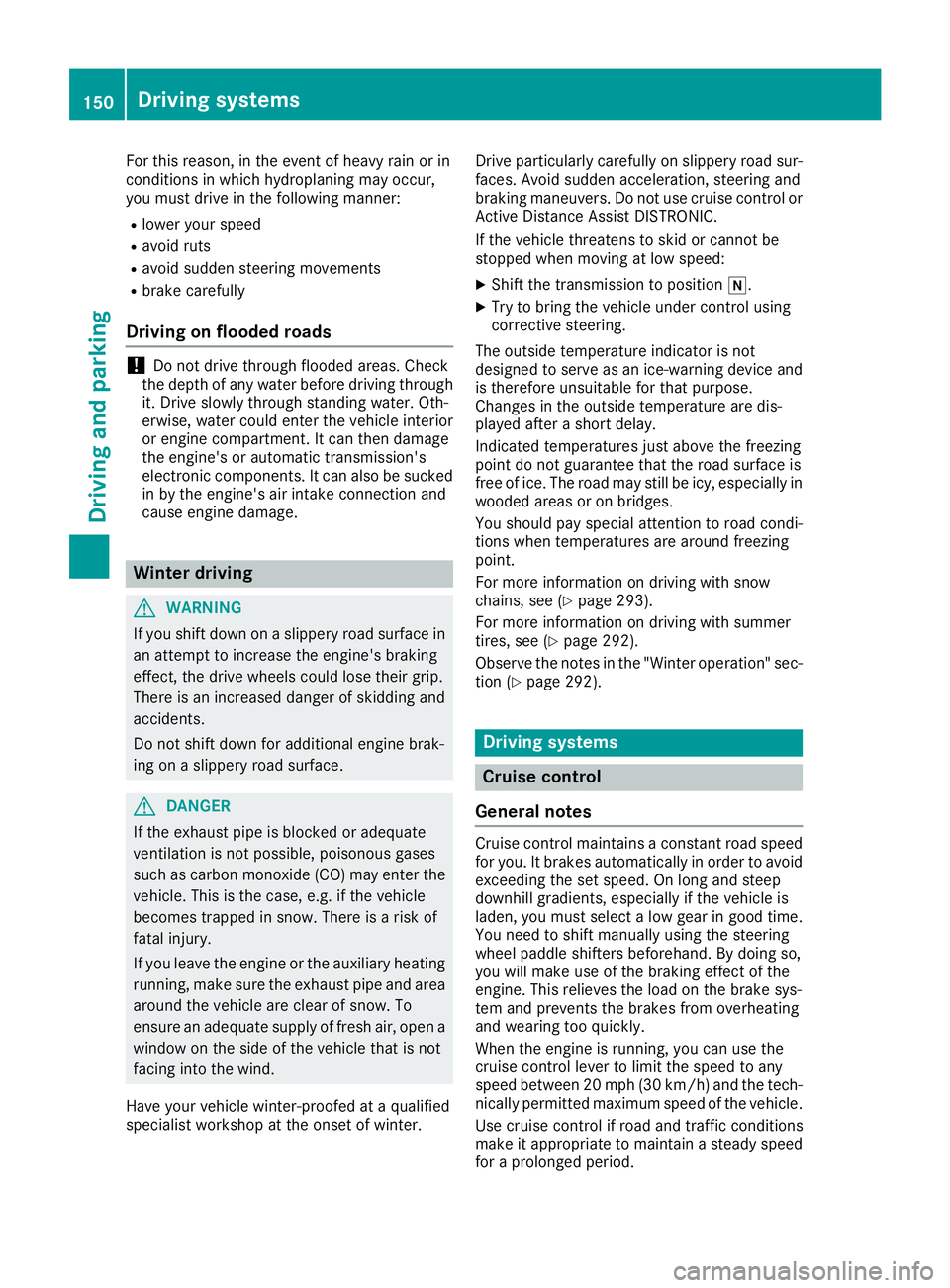
For this reason, in the event of heavy rain or inconditions in which hydroplaning may occur,you must drive in the following manner:
Rlower your speed
Ravoid ruts
Ravoid sudden steering movements
Rbrake carefully
Driving on flooded roads
!Do not drive through flooded areas. Checkthe depth of any water before driving throughit. Drive slowly through standing water. Oth-erwise, water could enter the vehicle interioror engine compartment. It can then damagethe engine's or automatic transmission'selectronic components. It can also be suckedin by the engine's air intake connection andcause engine damage.
Winter driving
GWARNING
If you shift down on a slippery road surface in
an attempt to increase the engine's braking
effect, the drive wheels could lose their grip.
There is an increased danger of skidding and
accidents.
Do not shift down for additional engine brak-
ing on a slippery road surface.
GDANGER
If the exhaust pipe is blocked or adequate
ventilation is not possible, poisonous gases
such as carbon monoxide (CO) may enter the
vehicle. This is the case, e.g. if the vehicle
becomes trapped in snow. There is a risk of
fatal injury.
If you leave the engine or the auxiliary heating
running, make sure the exhaust pipe and area
around the vehicle are clear of snow. To
ensure an adequate supply of fresh air, open a
window on the side of the vehicle that is not
facing into the wind.
Have your vehicle winter-proofed at a qualifiedspecialist workshop at the onset of winter.
Drive particularly carefully on slippery road sur-faces. Avoid sudden acceleration, steering andbraking maneuvers. Do not use cruise control orActive Distance Assist DISTRONIC.
If the vehicle threatens to skid or cannot bestopped when moving at low speed:
XShift the transmission to position�\\.
XTry to bring the vehicle under control usingcorrective steering.
The outside temperature indicator is notdesigned to serve as an ice-warning device andis therefore unsuitable for that purpose.Changes in the outside temperature are dis-played after a short delay.
Indicated temperatures just above the freezingpoint do not guarantee that the road surface isfree of ice. The road may still be icy, especially inwooded areas or on bridges.
You should pay special attention to road condi-tions when temperatures are around freezingpoint.
For more information on driving with snowchains, see (Ypage 293).
For more information on driving with summertires, see (Ypage 292).
Observe the notes in the "Winter operation" sec-tion (Ypage 292).
Driving systems
Cruise control
General notes
Cruise control maintains a constant road speedfor you. It brakes automatically in order to avoidexceeding the set speed. On long and steepdownhill gradients, especially if the vehicle isladen, you must select a low gear in good time.You need to shift manually using the steeringwheel paddle shifters beforehand. By doing so,you will make use of the braking effect of theengine. This relieves the load on the brake sys-tem and prevents the brakes from overheatingand wearing too quickly.
When the engine is running, you can use thecruise control lever to limit the speed to anyspeed between 20 mph (30 km/h) and the tech-nically permitted maximum speed of the vehicle.
Use cruise control if road and traffic conditionsmake it appropriate to maintain a steady speedfor a prolonged period.
150Driving systems
Driving and parking
Page 155 of 330
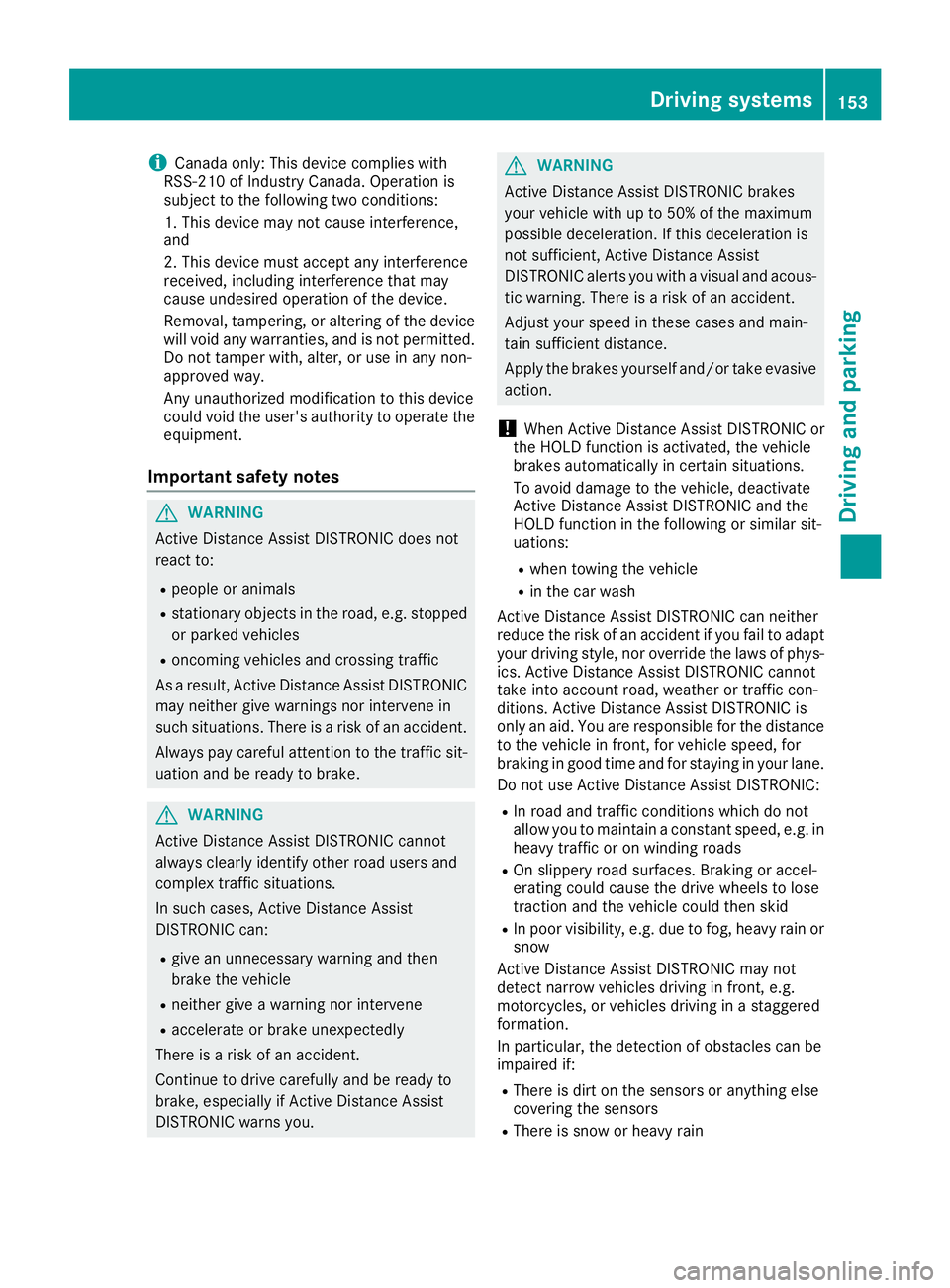
iCanada only: This device complies withRSS-210 of Industry Canada. Operation issubject to the following two conditions:
1. This device may not cause interference,and
2. This device must accept any interferencereceived, including interference that maycause undesired operation of the device.
Removal, tampering, or altering of the devicewill void any warranties, and is not permitted.Do not tamper with, alter, or use in any non-approved way.
Any unauthorized modification to this devicecould void the user's authority to operate theequipment.
Important safety notes
GWARNING
Active Distance Assist DISTRONIC does not
react to:
Rpeople or animals
Rstationary objects in the road, e.g. stopped
or parked vehicles
Roncoming vehicles and crossing traffic
As a result, Active Distance Assist DISTRONIC
may neither give warnings nor intervene in
such situations. There is a risk of an accident.
Always pay careful attention to the traffic sit-
uation and be ready to brake.
GWARNING
Active Distance Assist DISTRONIC cannot
always clearly identify other road users and
complex traffic situations.
In such cases, Active Distance Assist
DISTRONIC can:
Rgive an unnecessary warning and then
brake the vehicle
Rneither give a warning nor intervene
Raccelerate or brake unexpectedly
There is a risk of an accident.
Continue to drive carefully and be ready to
brake, especially if Active Distance Assist
DISTRONIC warns you.
GWARNING
Active Distance Assist DISTRONIC brakes
your vehicle with up to 50% of the maximum
possible deceleration. If this deceleration is
not sufficient, Active Distance Assist
DISTRONIC alerts you with a visual and acous-
tic warning. There is a risk of an accident.
Adjust your speed in these cases and main-
tain sufficient distance.
Apply the brakes yourself and/or take evasive
action.
!When Active Distance Assist DISTRONIC orthe HOLD function is activated, the vehiclebrakes automatically in certain situations.
To avoid damage to the vehicle, deactivateActive Distance Assist DISTRONIC and theHOLD function in the following or similar sit-uations:
Rwhen towing the vehicle
Rin the car wash
Active Distance Assist DISTRONIC can neitherreduce the risk of an accident if you fail to adaptyour driving style, nor override the laws of phys-ics. Active Distance Assist DISTRONIC cannottake into account road, weather or traffic con-ditions. Active Distance Assist DISTRONIC isonly an aid. You are responsible for the distanceto the vehicle in front, for vehicle speed, forbraking in good time and for staying in your lane.
Do not use Active Distance Assist DISTRONIC:
RIn road and traffic conditions which do notallow you to maintain a constant speed, e.g. inheavy traffic or on winding roads
ROn slippery road surfaces. Braking or accel-erating could cause the drive wheels to losetraction and the vehicle could then skid
RIn poor visibility, e.g. due to fog, heavy rain orsnow
Active Distance Assist DISTRONIC may notdetect narrow vehicles driving in front, e.g.motorcycles, or vehicles driving in a staggeredformation.
In particular, the detection of obstacles can beimpaired if:
RThere is dirt on the sensors or anything elsecovering the sensors
RThere is snow or heavy rain
Driving systems153
Driving and parking
Z
Page 158 of 330
![MERCEDES-BENZ CLA 2019 Owners Manual When Active Distance Assist DISTRONIC is acti-vated, the transmission is shifted automaticallyto position�]if:
Rthe driver's seat belt is not fastened and thedriver's door is open.
Rthe engine MERCEDES-BENZ CLA 2019 Owners Manual When Active Distance Assist DISTRONIC is acti-vated, the transmission is shifted automaticallyto position�]if:
Rthe driver's seat belt is not fastened and thedriver's door is open.
Rthe engine](/manual-img/4/59041/w960_59041-157.png)
When Active Distance Assist DISTRONIC is acti-vated, the transmission is shifted automaticallyto position�]if:
Rthe driver's seat belt is not fastened and thedriver's door is open.
Rthe engine is switched off, unless it is auto-matically switched off by the ECO start/stopfunction.
The electric parking brake is applied automati-cally if Active Distance Assist DISTRONIC isactive when the vehicle is stationary and:
Ra system malfunction occurs.
Rthe power supply is insufficient.
If a malfunction occurs, the transmission mayalso shift to position�]automatically.
Setting a speed
Keep in mind that it may take a brief momentuntil the vehicle has accelerated or braked tothe speed set.
XPress the cruise control lever up�Cfor ahigher speed or down�Dfor a lower speed.
XTo adjust the set speed in 1 mph incre-ments (1 km/h increments):briefly pushthe cruise control lever up�Cor down�Dtothe pressure point.The last stored speed increases or decreasesin 1 mph (1 km/h) increments.
XTo adjust the set speed in 5 mph incre-ments (10 km/h increments):briefly pushthe cruise control lever up�Cor down�Dbeyond the pressure point.The last stored speed increases or decreasesin 5 mph (10 km/h) increments.
iActive Distance Assist DISTRONIC is notdeactivated if you depress the acceleratorpedal. If you accelerate to overtake, ActiveDistance Assist DISTRONIC adjusts the vehi-cle's speed to the last speed stored, after youhave finished overtaking.
Setting a specified minimum distance
You can set the specified minimum distance forActive Distance Assist DISTRONIC by varyingthe time span between one and two seconds.This determines the distance that Active Dis-tance Assist DISTRONIC is to maintain from thevehicle in front, depending on the road speed.You can see this distance in the multifunctiondisplay (Ypage 157).
The specified minimum distance can bechanged while Active Distance AssistDISTRONIC is switched on or off.
iMake sure that you maintain the minimumdistance to the vehicle in front as required bylaw. Adjust the distance to the vehicle in frontif necessary.
XTo increase:turn control�
Page 159 of 330
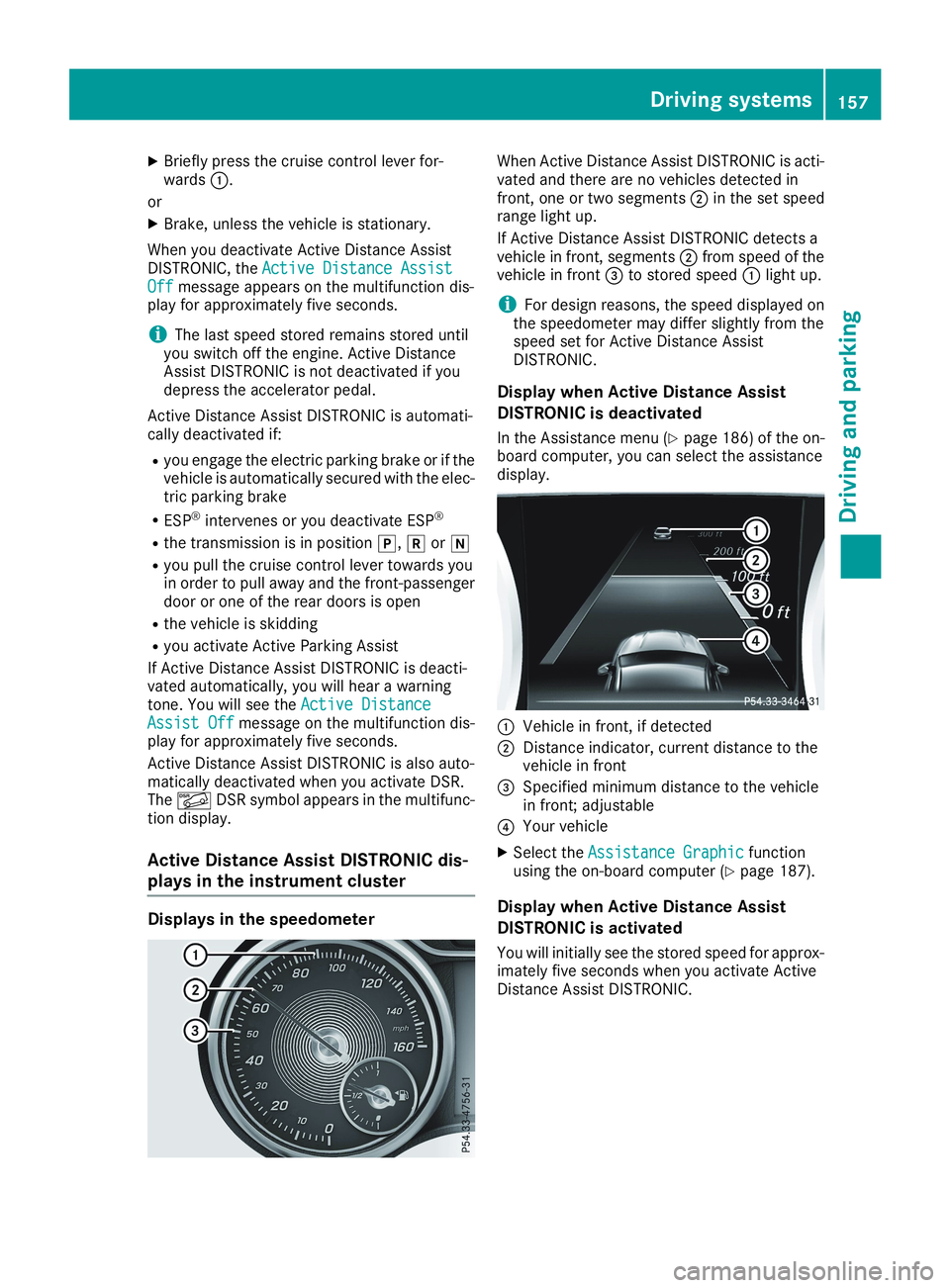
XBriefly press the cruise control lever for-wards�C.
or
XBrake, unless the vehicle is stationary.
When you deactivate Active Distance AssistDISTRONIC, theActive Distance AssistActive Distance AssistOffOffmessage appears on the multifunction dis-play for approximately five seconds.
iThe last speed stored remains stored untilyou switch off the engine. Active DistanceAssist DISTRONIC is not deactivated if youdepress the accelerator pedal.
Active Distance Assist DISTRONIC is automati-cally deactivated if:
Ryou engage the electric parking brake or if thevehicle is automatically secured with the elec-tric parking brake
RESP®intervenes or you deactivate ESP®
Rthe transmission is in position�],�^or�\\
Ryou pull the cruise control lever towards youin order to pull away and the front-passengerdoor or one of the rear doors is open
Rthe vehicle is skidding
Ryou activate Active Parking Assist
If Active Distance Assist DISTRONIC is deacti-vated automatically, you will hear a warningtone. You will see theActive DistanceActive DistanceAssist OffAssist Offmessage on the multifunction dis-play for approximately five seconds.
Active Distance Assist DISTRONIC is also auto-matically deactivated when you activate DSR.The�
Page 161 of 330

!When Active Distance Assist DISTRONIC orthe HOLD function is activated, the vehiclebrakes automatically in certain situations.
To avoid damage to the vehicle, deactivateActive Distance Assist DISTRONIC and theHOLD function in the following or similar sit-uations:
Rwhen towing the vehicle
Rin the car wash
Deactivating the HOLD function (Ypage 159).
Activation conditions
You can activate the HOLD function if:
Rthe vehicle is stationary
Rthe engine is running or if it has been auto-matically switched off by the ECO start/stopfunction
Rthe driver's door is closed or your seat belt isfastened
Rthe electric parking brake is released
RActive Distance Assist DISTRONIC is deacti-vated
Rthe transmission is in position�[,�^or�\\on vehicles with automatic transmission
Activating the HOLD function
XMake sure that the activation conditions aremet.
XDepress the brake pedal.
XQuickly depress the brake pedal furtheruntil�Cappears in the multifunction display.The HOLD function is activated. You canrelease the brake pedal.
iIf depressing the brake pedal the first timedoes not activate the HOLD function, waitbriefly and then try again.
Deactivating the HOLD function
The HOLD function is deactivated automaticallyif:
Ryou accelerate. On vehicles with automatictransmission: only when the transmission is inposition�[or�^.
Rthe transmission is in position�]on vehicleswith automatic transmission.
Ryou depress the brake pedal again with a cer-tain amount of pressure until�Cdisappearsfrom the multifunction display.
Ryou activate Active Distance AssistDISTRONIC.
Ryou secure the vehicle using the electric park-ing brake.
iAfter a time, the electric parking brakesecures the vehicle and relieves the servicebrake.
When the HOLD function is activated, the trans-mission is automatically shifted to position�]if:
Rthe driver's seat belt is not fastened and thedriver's door is open
Rthe engine is switched off, unless it is auto-matically switched off by the ECO start/stopfunction
The electric parking brake secures the vehicleautomatically if the HOLD function is activatedwhen the vehicle is stationary and:
Ra system malfunction occurs
Rthe power supply is insufficient
Start-off Assist (except Mercedes-
AMG vehicles)
Important safety notes
GWARNING
If you use start-off assist, individual wheels
may start to spin and the vehicle may skid. If
ESP®is deactivated, there is a greater danger
of skidding and having an accident. Make sure
that no persons or obstacles are in the vicinity
of the vehicle.
Start-off assist enables optimum accelerationfrom a standstill. For this, a suitably high-grip
Driving systems159
Driving and parking
Z
Page 162 of 330
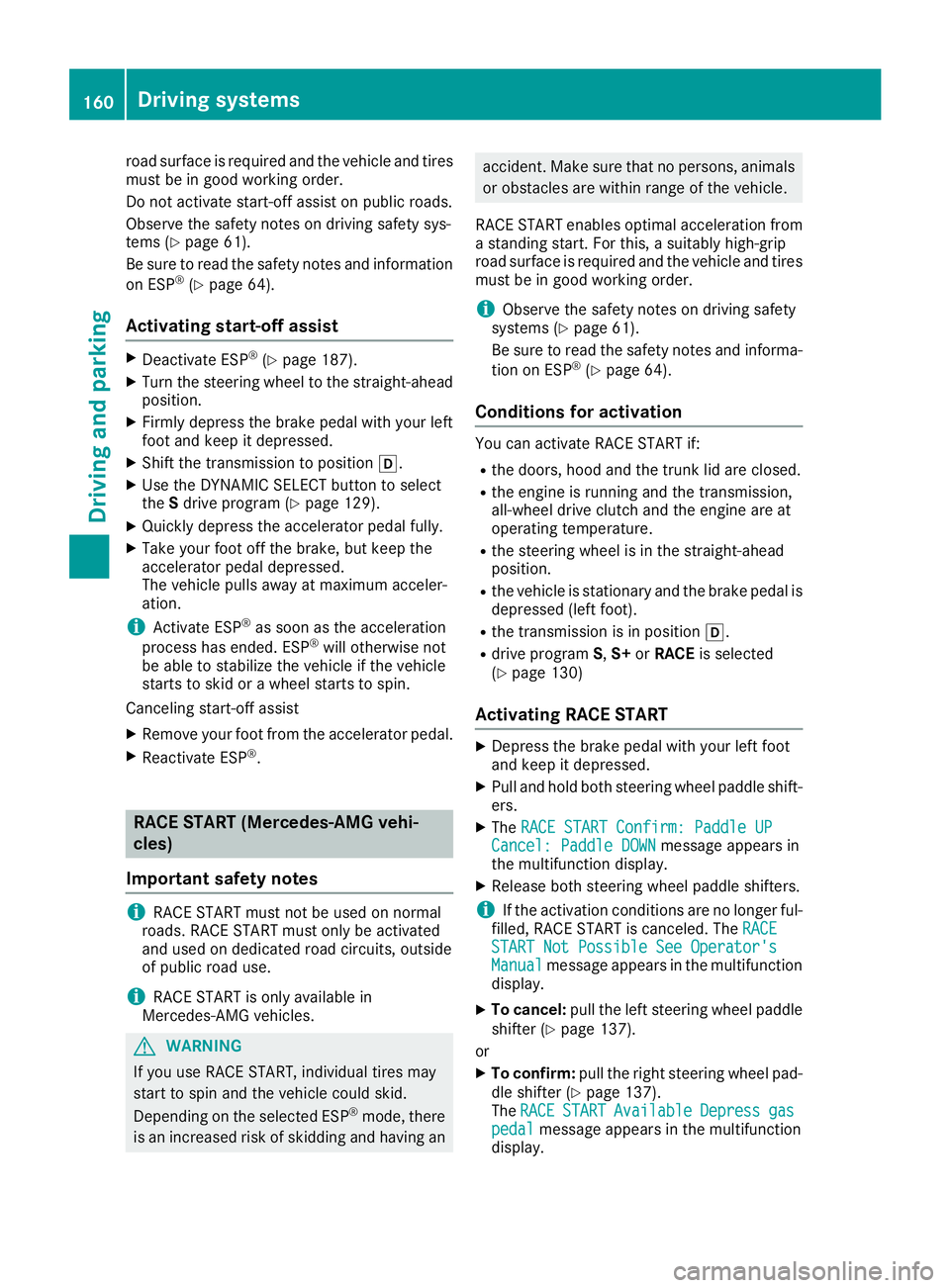
road surface is required and the vehicle and tiresmust be in good working order.
Do not activate start-off assist on public roads.
Observe the safety notes on driving safety sys-tems (Ypage 61).
Be sure to read the safety notes and information
on ESP®(Ypage 64).
Activating start-off assist
XDeactivate ESP®(Ypage 187).
XTurn the steering wheel to the straight-aheadposition.
XFirmly depress the brake pedal with your leftfoot and keep it depressed.
XShift the transmission to position�[.
XUse the DYNAMIC SELECT button to selecttheSdrive program (Ypage 129).
XQuickly depress the accelerator pedal fully.
XTake your foot off the brake, but keep theaccelerator pedal depressed.The vehicle pulls away at maximum acceler-ation.
iActivate ESP®as soon as the acceleration
process has ended. ESP®will otherwise notbe able to stabilize the vehicle if the vehiclestarts to skid or a wheel starts to spin.
Canceling start-off assist
XRemove your foot from the accelerator pedal.
XReactivate ESP®.
RACE START (Mercedes-AMG vehi-
cles)
Important safety notes
iRACE START must not be used on normalroads. RACE START must only be activatedand used on dedicated road circuits, outsideof public road use.
iRACE START is only available inMercedes‑AMG vehicles.
GWARNING
If you use RACE START, individual tires may
start to spin and the vehicle could skid.
Depending on the selected ESP®mode, there
is an increased risk of skidding and having an
accident. Make sure that no persons, animals
or obstacles are within range of the vehicle.
RACE START enables optimal acceleration froma standing start. For this, a suitably high-griproad surface is required and the vehicle and tiresmust be in good working order.
iObserve the safety notes on driving safetysystems (Ypage 61).
Be sure to read the safety notes and informa-
tion on ESP®(Ypage 64).
Conditions for activation
You can activate RACE START if:
Rthe doors, hood and the trunk lid are closed.
Rthe engine is running and the transmission,all-wheel drive clutch and the engine are atoperating temperature.
Rthe steering wheel is in the straight-aheadposition.
Rthe vehicle is stationary and the brake pedal isdepressed (left foot).
Rthe transmission is in position�[.
Rdrive programS,S+orRACEis selected(Ypage 130)
Activating RACE START
XDepress the brake pedal with your left footand keep it depressed.
XPull and hold both steering wheel paddle shift-ers.
XTheRACE START Confirm: Paddle UPRACE START Confirm: Paddle UPCancel: Paddle DOWNCancel: Paddle DOWNmessage appears inthe multifunction display.
XRelease both steering wheel paddle shifters.
iIf the activation conditions are no longer ful-filled, RACE START is canceled. TheRACERACESTART Not Possible See Operator'sSTART Not Possible See Operator'sManualManualmessage appears in the multifunctiondisplay.
XTo cancel:pull the left steering wheel paddleshifter (Ypage 137).
or
XTo confirm:pull the right steering wheel pad-dle shifter (Ypage 137).TheRACERACESTARTSTARTAvailableAvailableDepressDepressgasgaspedalpedalmessage appears in the multifunctiondisplay.
160Driving systems
Driving and parking
Page 163 of 330
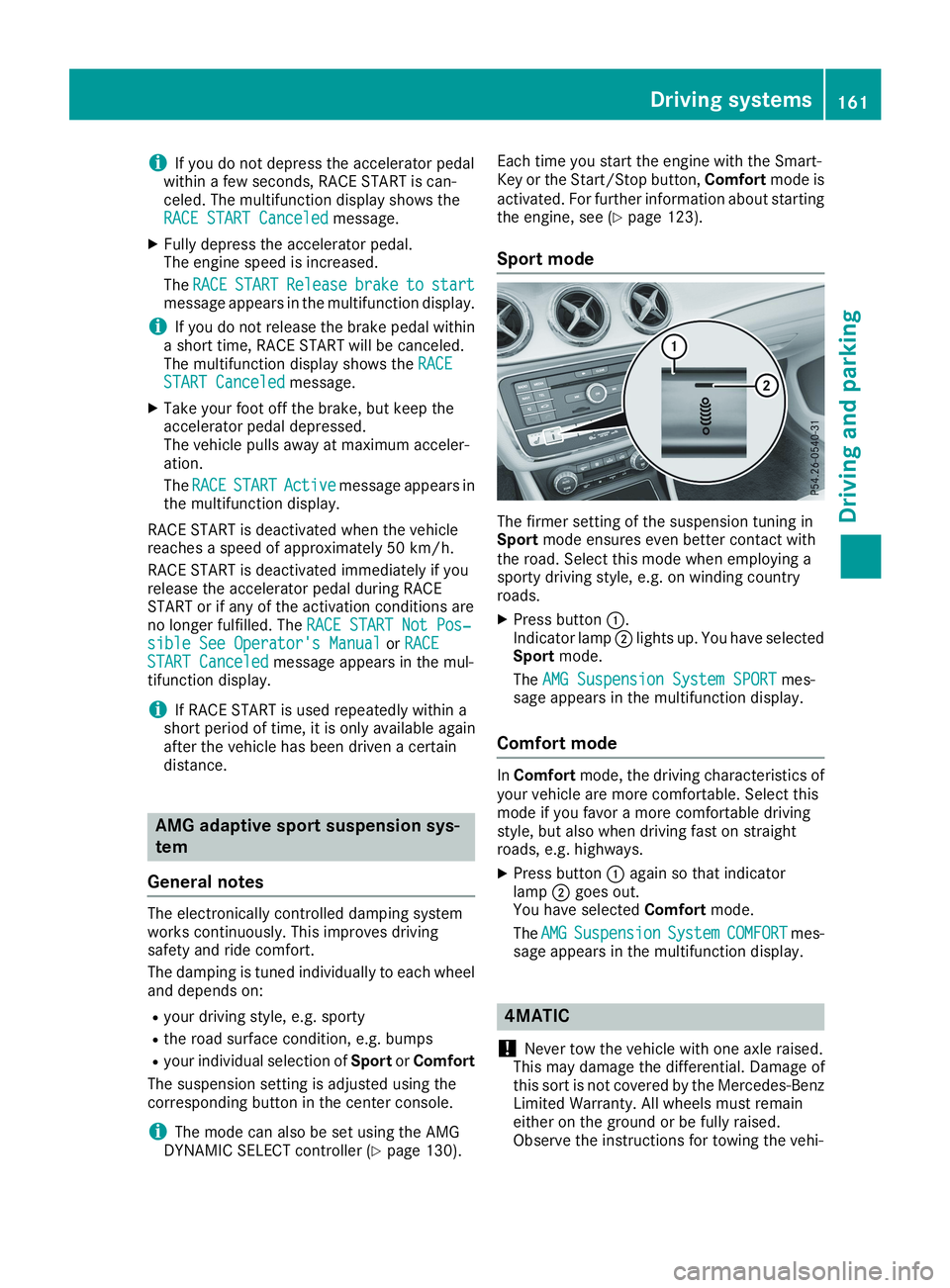
iIf you do not depress the accelerator pedalwithin a few seconds, RACE START is can-celed. The multifunction display shows theRACE START CanceledRACE START Canceledmessage.
XFully depress the accelerator pedal.The engine speed is increased.
TheRACERACESTARTSTARTReleaseReleasebrakebraketotostartstartmessage appears in the multifunction display.
iIf you do not release the brake pedal withina short time, RACE START will be canceled.The multifunction display shows theRACERACESTART CanceledSTART Canceledmessage.
XTake your foot off the brake, but keep theaccelerator pedal depressed.The vehicle pulls away at maximum acceler-ation.
TheRACERACESTARTSTARTActiveActivemessage appears inthe multifunction display.
RACE START is deactivated when the vehiclereaches a speed of approximately 50 km/h.
RACE START is deactivated immediately if yourelease the accelerator pedal during RACESTART or if any of the activation conditions areno longer fulfilled. TheRACE START Not Pos‐RACE START Not Pos‐sible See Operator's Manualsible See Operator's ManualorRACERACESTART CanceledSTART Canceledmessage appears in the mul-tifunction display.
iIf RACE START is used repeatedly within ashort period of time, it is only available againafter the vehicle has been driven a certaindistance.
AMG adaptive sport suspension sys-
tem
General notes
The electronically controlled damping systemworks continuously. This improves drivingsafety and ride comfort.
The damping is tuned individually to each wheeland depends on:
Ryour driving style, e.g. sporty
Rthe road surface condition, e.g. bumps
Ryour individual selection ofSportorComfort
The suspension setting is adjusted using thecorresponding button in the center console.
iThe mode can also be set using the AMGDYNAMIC SELECT controller (Ypage 130).
Each time you start the engine with the Smart-Key or the Start/Stop button,Comfortmode isactivated. For further information about startingthe engine, see (Ypage 123).
Sport mode
The firmer setting of the suspension tuning inSportmode ensures even better contact withthe road. Select this mode when employing asporty driving style, e.g. on winding countryroads.
XPress button�C.Indicator lamp�Dlights up. You have selectedSportmode.
TheAMG Suspension System SPORTAMG Suspension System SPORTmes-sage appears in the multifunction display.
Comfort mode
InComfortmode, the driving characteristics ofyour vehicle are more comfortable. Select thismode if you favor a more comfortable drivingstyle, but also when driving fast on straightroads, e.g. highways.
XPress button�Cagain so that indicatorlamp�Dgoes out.You have selectedComfortmode.
TheAMGAMGSuspensionSuspensionSystemSystemCOMFORTCOMFORTmes-sage appears in the multifunction display.
4MATIC
!Never tow the vehicle with one axle raised.This may damage the differential. Damage ofthis sort is not covered by the Mercedes-BenzLimited Warranty. All wheels must remaineither on the ground or be fully raised.Observe the instructions for towing the vehi-
Driving systems161
Driving and parking
Z
Page 164 of 330
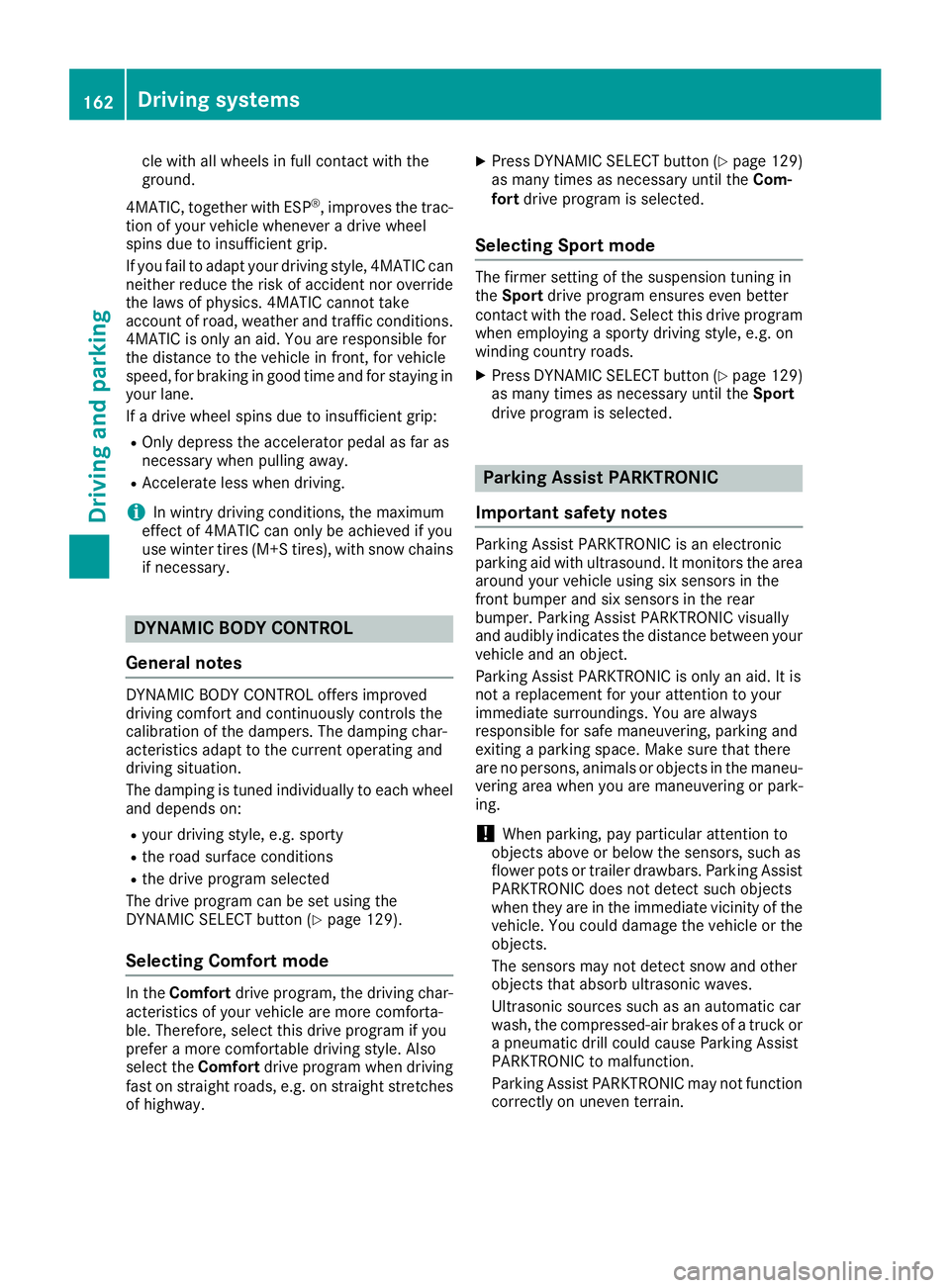
cle with all wheels in full contact with theground.
4MATIC, together with ESP®, improves the trac-tion of your vehicle whenever a drive wheelspins due to insufficient grip.
If you fail to adapt your driving style, 4MATIC canneither reduce the risk of accident nor overridethe laws of physics. 4MATIC cannot takeaccount of road, weather and traffic conditions.4MATIC is only an aid. You are responsible forthe distance to the vehicle in front, for vehiclespeed, for braking in good time and for staying inyour lane.
If a drive wheel spins due to insufficient grip:
ROnly depress the accelerator pedal as far asnecessary when pulling away.
RAccelerate less when driving.
iIn wintry driving conditions, the maximumeffect of 4MATIC can only be achieved if youuse winter tires (M+S tires), with snow chainsif necessary.
DYNAMIC BODY CONTROL
General notes
DYNAMIC BODY CONTROL offers improveddriving comfort and continuously controls thecalibration of the dampers. The damping char-acteristics adapt to the current operating anddriving situation.
The damping is tuned individually to each wheeland depends on:
Ryour driving style, e.g. sporty
Rthe road surface conditions
Rthe drive program selected
The drive program can be set using theDYNAMIC SELECT button (Ypage 129).
Selecting Comfort mode
In theComfortdrive program, the driving char-acteristics of your vehicle are more comforta-ble. Therefore, select this drive program if youprefer a more comfortable driving style. Alsoselect theComfortdrive program when drivingfast on straight roads, e.g. on straight stretchesof highway.
XPress DYNAMIC SELECT button (Ypage 129)as many times as necessary until theCom-fortdrive program is selected.
Selecting Sport mode
The firmer setting of the suspension tuning intheSportdrive program ensures even bettercontact with the road. Select this drive programwhen employing a sporty driving style, e.g. onwinding country roads.
XPress DYNAMIC SELECT button (Ypage 129)as many times as necessary until theSportdrive program is selected.
Parking Assist PARKTRONIC
Important safety notes
Parking Assist PARKTRONIC is an electronicparking aid with ultrasound. It monitors the areaaround your vehicle using six sensors in thefront bumper and six sensors in the rearbumper. Parking Assist PARKTRONIC visuallyand audibly indicates the distance between yourvehicle and an object.
Parking Assist PARKTRONIC is only an aid. It isnot a replacement for your attention to yourimmediate surroundings. You are alwaysresponsible for safe maneuvering, parking andexiting a parking space. Make sure that thereare no persons, animals or objects in the maneu-vering area when you are maneuvering or park-ing.
!When parking, pay particular attention toobjects above or below the sensors, such asflower pots or trailer drawbars. Parking AssistPARKTRONIC does not detect such objectswhen they are in the immediate vicinity of thevehicle. You could damage the vehicle or theobjects.
The sensors may not detect snow and otherobjects that absorb ultrasonic waves.
Ultrasonic sources such as an automatic carwash, the compressed-air brakes of a truck ora pneumatic drill could cause Parking AssistPARKTRONIC to malfunction.
Parking Assist PARKTRONIC may not functioncorrectly on uneven terrain.
162Driving systems
Driving an d parking